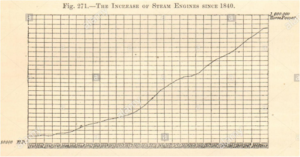Let’s start back in the 1850s. The impressive image above is the Impulsoria, designed by Clemente Masserano in 1851. It’s a very well constructed engine for the transportation of train carriages. It had an output of 2-4 horsepower (depending on how many horses you put on it) and in the 1850s it made good sense. The Impulsoria could pull more carriages and travel faster than the steam engines of the time. It got built, it got trialed, but then this happened…
Steam engines started to power up. The graph above shows the increasing power of steam engines from approximately 1840-1880. The front end of an exponential curve can look flat, and when the Impulsoria was proposed, they didn’t realise the power of steam engines was about to change dramatically.
I believe we are at the front of an exponential curve in professional services. You might not find much about AI and technology in engineering but you can see it clearly in medicine, law and accounting.
It’s something we really need to think about. To stay relevant we need to effectively adapt our learning to what is effectively a new engine. We need to put our engineering together in ways that mean we can leverage AI, machine learning, and all the tools that software developers use these days. We can use these to build ‘factories’ – not physical ones but professional services factories.
There are three core things fundamental to this vision of the future. Coding, Statistics and Machine Learning.
Being able to code is an important part of your tool kit for the future. As a quick point, excel is not a programming language. However, if you know how to write some functions in excel you are not far from programming. We’ve been using Google Prolab. It’s a browser development environment which makes it very accessible. We’ve used it quite successfully to create some of our baseline code environments.
At Brevity we have chosen to share our codes. This is common in the world of software and has driven their exponential growth. We have started sharing open source code (find them here). At this point we have included libraries and methods for 1170.0 and 1170.5 calculations. Consider the time every engineer in every firm spends working out the answers to standard questions. Then consider the time other engineers spend reviewing their work and checking their decisions. Given it’s information we already agree on, it is time wasted.
The coding is just the beginning. Coding is the process, but it is data that is driving the outcomes. That’s where statistics comes in. Engineers of the future will need to understand how to collect and organise data in ways that unleash the power of the information. Combining the code and the structured data enables machine learning/AI to really speed things up. Welcome to the next exponential curve.
The use of artificial intelligence will free engineers from the standardised work of today and allow more time to focus on the wicked problems facing our world instead.
If we revisit the curve at the beginning of the article, it represents the exponential increase in steam power. This innovation drove the industrial revolution and the many advances in machinery that followed. Engineers created the planes, trains, cars, and machines that have been a cause of global warming. The responsibility now lies with us to create the solutions. Collaborating to achieve this vision, sharing our knowledge and progress, and using the most advanced tools available will allow us to do this.
If you would like to know more about Brevity’s journey to automation, please get in touch. We are very happy to share our experiences and learnings.
The Ground is Shifting: 5 Key Changes to NZ Building Law You Need to Know
KEY TOPICS COVERED: Standards in Flux: The tricky situation with the wind actions standard AS/NZS 1170.2, where the…
Building a Custom SketchUp Extension in Four Days: Lessons Learned
Mastering AI-assisted development unlocks the potential to rapidly create complex tools, like a custom SketchUp…
A Unified Step Forward: Strengthening Seismic Resilience in Building Design
Two key documents, the AWCI Code of Practice for Suspended Ceilings and the BIP Code of Practice for the Seismic…


